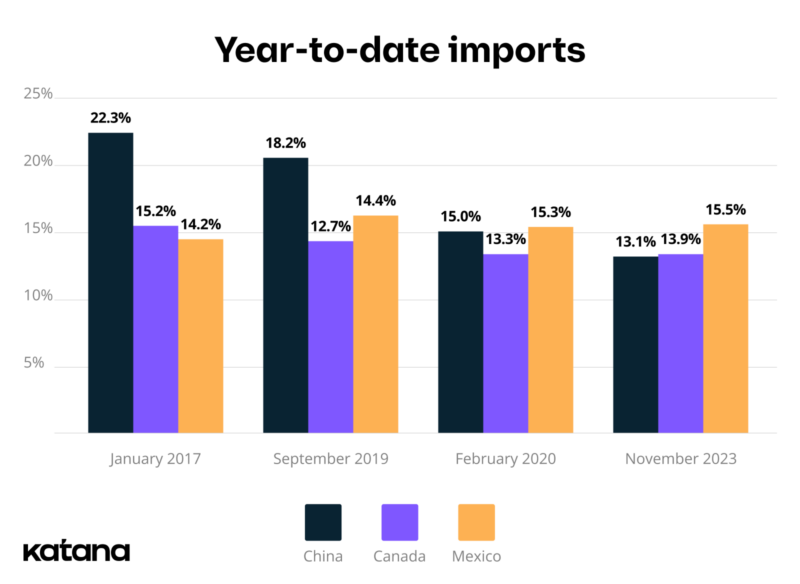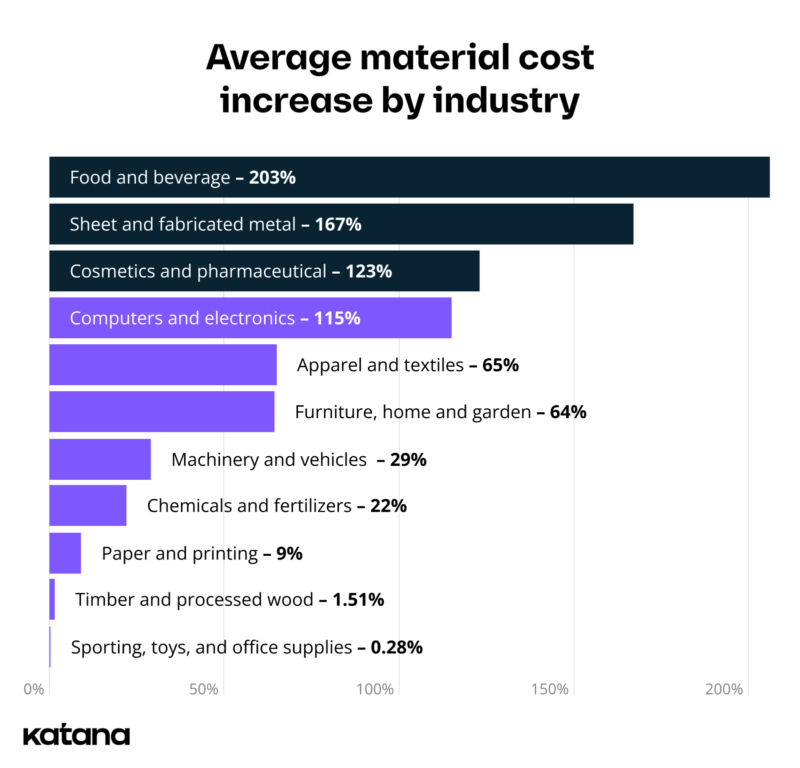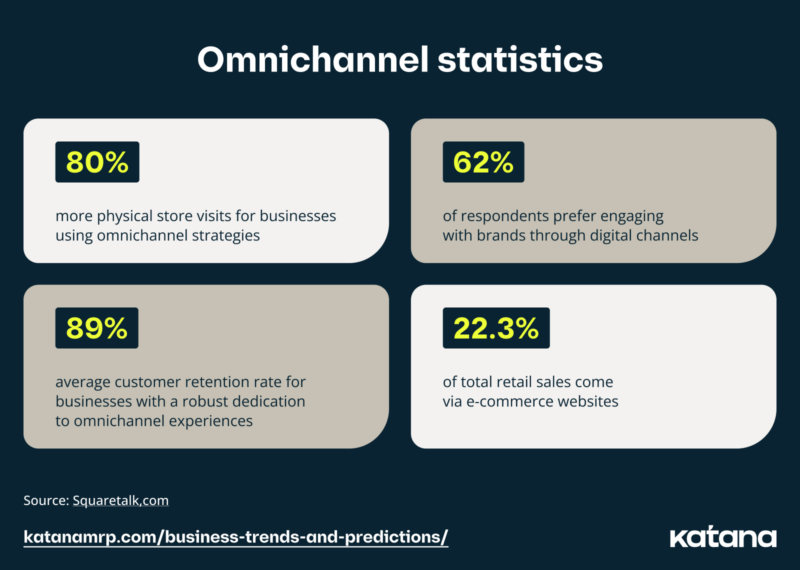Trends and predictions for businesses in 2024
Here are our detailed business trends and predictions for 2024, focusing on AI implementation, reshoring, rising costs, omnichannel selling, and sustainability.

James Humphreys
At this point, it’s safe to say that anything can happen that will force businesses to adapt and improve to keep moving forward. However, even though some things can be unpredictable, looking at the last several years, we can forecast what will likely happen within the next 12 months. Here are our business trends for 2024 for companies handling physical goods.

Key takeaways on our business predictions
- 40% of AI applications used by businesses are for improving inventory management
- The average number of AI capabilities utilized by businesses doubled from 1.9 to 3.6
- Imports from Mexico to the US have increased from $320 billion to $402 billion — a 26% increase
- 96% of CEOs were already evaluating reshoring their operations or had already done so
- 78% of small businesses have noted price increases
- Companies with an agile business model experienced a 10% higher total shareholder return during the Covid-19 pandemic compared to less resilient companies
- Businesses using at least three channels in a marketing campaign earned a 494% higher order rate than businesses using just one channel
- The annual count of climate-related disasters will increase to 560 a year by 2030, marking a 40% surge from the levels recorded in 2015
- Solar photovoltaic energy costs have decreased by 83%, and wind energy costs have decreased by 40%
1. AI implementation will improve business operations drastically
AI isn’t just a buzzword anymore — it’s here now and will stay put until governmental interventions.
Until then, current business trends show that businesses will greatly improve their operations by integrating AI into their workflows and current tech stacks.
The creation of AI tools has accelerated in recent years, primarily in machine learning and generative AI. Many businesses are already enjoying the fruits of using AI in their operations, from chatbots to virtual assistants. But as more complex AI systems are created, we’re only going to see the rate of adoption increase.
For example, from 2018 to 2022, the average number of AI capabilities being utilized by businesses doubled from 1.9 to 3.6¹.
According to the annual McKinsey Global Survey² on the present state of AI, the adoption of AI tools is still increasing. Almost one-quarter of C-suite executives surveyed reveal that they regularly use generative AI tools, and over one-quarter of respondents mention that generative AI is already part of their boards’ agendas. Of those participants surveyed, 40% express their organizations’ intent to increase overall AI investment due to advancements in generative AI.
As of now, businesses have been so far using AI mainly in these four areas³ (however, the adoption of AI is not limited to these operations):
- 46% Customer relationship management
- 47% Digital personal assistants
- 40% Inventory management
- 35% Content production
Methodology
This article uses proprietary data from Katana Cloud Inventory Software and external sources to compile our trends and predictions for 2024. Katana facilitated a total customer revenue of $2 billion from sales in 2023. From large multi-million-dollar enterprises to small-scale entrepreneurs, Katana assists SMBs in effectively managing their sales and inventory. Katana boasts an average customer rating of 4.8 out of 5 — recognized by reputable review platforms such as G2, Capterra, and Software Advice as an industry-leading inventory management solution.
2. Businesses will continue to reshore their operations
The media has long proclaimed that the Made in China era is over⁴.
And after over 30 years of continuous economic growth, what caused this? China has been facing challenges in its real estate market, a crucial aspect of its economy, with major developers collapsing and property prices declining. Other economic indicators and business trends, such as deflation, decreasing exports, and slowing GDP growth, suggest a fundamental shift in China’s economic trajectory.
With China restructuring its supply chains and governmental policies and experiencing a decline in global confidence as a stable investment destination, more and more businesses are reshoring their operations.
For example, the US has been importing more manufactured goods from Mexico. Since Covid-19, imports from Mexico have increased from $320 billion to $402 billion — a 26% increase⁵. According to the same report from Kearney in 2022, 96% of CEOs were already evaluating reshoring their operations or had already done so.
Using data from the United States Census Bureau⁶, you can see that America’s reliance on Chinese-produced goods has been declining over the last several years:

3. Rising costs will be a driving force toward efficiency
The last few years have been turbulent, to say the least:
- A global pandemic
- Several major conflicts
- US inflation reaching as high as 8%
- Increasing natural disasters due to global warming
The list goes on.
These issues have all contributed to rising costs for housing, food, taxes, and healthcare. And unfortunately, these prices are only going to continue to rise (albeit slowly, hopefully) as the Federal Reserve intends to get inflation to 2%⁷. This might be disconcerting for our wallets, but ultimately, prices falling or deflation can lead to subdued economic growth.
But what does this all mean for businesses? Looking at Katana customers, here’s the average price increase on raw materials for industries from 2022 to 2023:

As you can see, most have experienced large increases in the costs of their raw materials.
And it’s not just Katana customers that have been affected by the business trends of rising costs. According to the United States Census Bureau⁷, 78% of small businesses have noted price increases. And what does this mean going forward?
Recognizing the significance of organizational resilience, more than 60% of respondents in the State of Organizations Survey⁸ believe it will only become more important in the future. Currently, only 14% of respondents indicate that their organizations have fully adopted an agile operating model.
When looking at McKinsey’s findings, building and adopting a resilient business model proved to be a major competitive advantage during the peak of the Covid-19 pandemic, as resilient companies generated 10% more total shareholder return (TSR) than less resilient businesses during the economic downturn from Q4 2019 to Q2 2020. As the economy recovered from Q2 2020 to Q3 2021, this differential expanded to as much as 50%.
One way businesses manage rising costs is by implementing real-time software into their operations to easily manage stock levels with insights to predict customer demand and avoid delays with proper inventory planning and forecasting. Does this sound like something your business needs?
Inventory planning and forecasting
Effectively control your inventory by utilizing insights that enable you to anticipate customer demand and prevent delays through efficient inventory planning and forecasting.
4. Omnichannel selling will become the gold standard
It could even be argued that this is already the case.
According to Omnisend⁹, businesses using at least three channels in a marketing campaign earned a 494% higher order rate than businesses using just one channel. Forrester predicts that by 2028, click-and-collect sales will exceed $200 billion in the US, while offline retail sales will reach $4.2 trillion¹⁰. These figures all highlight the importance of adopting an omnichannel sales and marketing strategy in your business operations.
Ensuring a cohesive and unified shopping journey across various online and offline platforms is crucial to addressing the requirements of an interconnected customer base.
There are several benefits associated with omnichannel selling, such as:
- Enhanced customer experience
- Consistent brand image
- Increased customer loyalty
- Data integration and insights
- Improved inventory management
- Cross-channel marketing opportunities
- Flexible fulfillment options
- Adaptation to changing consumer behavior
- Competitive advantage
- Revenue growth
Omnichannel selling is about creating a holistic and interconnected customer experience, and the benefits extend beyond just sales to encompass improved customer satisfaction, loyalty, and operational efficiency.

5. A focus on sustainability will increase, but difficult to achieve
According to the World Meteorological Organization¹¹, should the present trajectory continue, there is a potential for the annual count of climate-related disasters to increase to 560 a year by 2030, marking a 40% surge from the levels recorded in 2015.
Governments are enacting policies to try and reduce their carbon footprint. For example, the German Supply Chain Due Diligence Act¹² mandates that eligible companies perform due diligence on human rights and environmental aspects to identify potential risks, address concerns, and establish mechanisms for handling grievances, among other obligations. Many would agree that it is a step in the right direction.
However, the world is more complicated than that.
The Russia-Ukraine conflict in 2022 sparked a global energy crisis due to unprecedented price increases and disruption in the supply chain. Certain countries, including Germany, relaxed regulations governing the operation of coal-fired power facilities, and others opted to prolong the operational lifespans of both coal and nuclear power plants¹³. This means that restricting global warming to a range of 1.5 to 2 degrees Celsius compared to preindustrial levels as per the Paris Agreement becomes increasingly unlikely.
But there are signs on the horizon that transitioning a company’s operation to be more environmentally friendly will be easier and have benefits.
Since 2010, solar photovoltaic energy costs have decreased by 83%, and wind energy costs have decreased by 40%¹⁴. And according to Future Business¹⁵, 66% of US consumers are willing to pay more if it means they’re purchasing sustainable products.
Converting your processes and operations to be environmentally conscious doesn’t have to be with the adoption of green technology. It could be as simple as reducing the amount of waste you produce, be that from discarded materials or unnecessary orders. Finding a tool with planning and forecasting capabilities will enable you to:
- Make production and purchasing decisions in real time
- Prevent stockouts and overstocking from occurring
- Improve your supply chain efficiency
Navigating business trends for future success
The evolving landscape of business operations presents both challenges and opportunities. To reiterate:
- The integration of AI is no longer a mere trend but a transformative force
- There is a notable shift in global supply chains, marked by businesses reshoring their operations amid changes in China’s economic dynamics
- Rising costs, exacerbated by global crises and inflation, underscore the need for businesses to prioritize efficiency and resilience
- Omnichannel selling offers businesses a multifaceted approach to marketing and sales
- Sustainability is a rising priority, driven by both governmental regulations and consumer preferences
In the face of these multifaceted trends, businesses are urged to find and incorporate solutions into their day-to-day operations to help them keep up and outperform their competition with the right tech stack.
Katana Cloud Inventory helps businesses handle physical inventory to better connect with their customers, partners, and favorite business tools to create a cohesive workflow from purchases to sales. Katana does this by giving businesses access to features such as:
- Live inventory management
- Built-in purchase order management
- Omnichannel sales management
- Production management
- Financial visibility via cloud accounting
Adapting to these business trends in 2024 outlined in the article will position businesses for success and contribute to a more sustainable and resilient global business ecosystem. Book a demo and see how Katana can help set you on the right path to achieving resilience, efficiency, and waste reduction.
Sources for Katana’s business predictions and trends for 2024
¹ The state of AI in 2022—and a half decade in review, McKinsey (2022)
² The state of AI in 2023: Generative AI’s breakout year, McKinsey (2023)
³ How Businesses Are Using Artificial Intelligence In 2024, Forbes (2023)
⁴ It’s official: The era of China’s global dominance is over, Business Insider (2023)
⁵ America is ready for reshoring. Are you?, Kearney (2022)
⁶ Top Trading Partners – November 2023, United States Census Bureau (2023)
⁷ Economic Surveys Show Drop in Supply Delays Since Peak of COVID-19, Higher Prices Due to Inflation, United States Census Bureau (2023)
⁸ The State of Organizations 2023, McKinsey (2023)
⁹ What we can learn from omnichannel statistics for 2022, Omnisend (2022)
¹⁰ US Offline Retail Sales Will Reach $4.2 Trillion By 2028, Forrester (2023)
¹¹ Early Warnings for All officially becomes WMO’s top priority, World Meteorological Organization (2023)
¹² Act on Corporate Due Diligence Obligations in Supply Chains, Federal Ministry of Labour and Social Affairs (2023)
¹³ Key sustainability trends that will drive decision-making in 2023, S&P Global (2023)
¹⁴ What are the likely costs of the transition to a sustainable economy?, Economics Observatory (2021)
¹⁵ How Much Does it Cost to Hit Sustainability Goals?, FutureBusiness (2023)

James Humphreys
Table of contents
Get inventory trends, news, and tips every month
Get visibility over your sales and stock
Wave goodbye to uncertainty by using Katana Cloud Inventory for total inventory control
